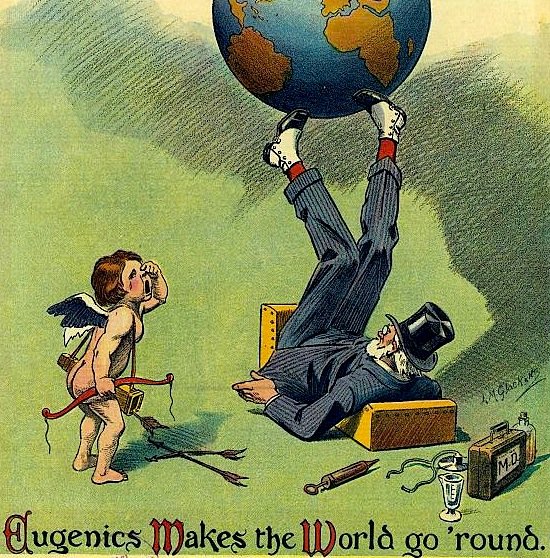1894 Puck magazine cover shows a well-dressed old man wearing a top hat and spats, lying on his back, bouncing the earth on his feet. A doctor's bag is in the foreground next to a weeping cherub. Photo Courtesy of the Library of Congress
On the Radio
WAMU report from Aug. 6, 2012: http://wamu.org/new…">Virginia Legislator Confronts Virginia's Dark History Of Eugenics.
The number of victims is unknown in Virginia’s system of forced sterilization, a dark chapter that stretched from the 1920s into the 1970s. Estimates range from 7,500 to 8,000 — an indication that many survivors could still be alive today. That’s why Del. Patrick Hope (D-47) wants the governor and General Assembly to put together a task force to track down survivors and determine just compensation.
“Most people equate this with Nazi Germany,” said Hope. “But, in fact, it originated right here in the commonwealth of Virginia.”
Hope said he was inspired by an effort in North Carolina, where the state government is considering a $10 million package to compensate victims of forced sterilization. That effort has the support of Democratic Gov. Beth Perdue and the Republican-led House of Representatives, although the Republican-led state Senate has blocked legislation. Hope said he’s not sure if $10 million would be appropriate for Virginia or not, but he added that the commonwealth already pays victims who have been wrongfully convicted receive $40,000 for each year they spent behind bars.
“These people are dying all the time,” said Hope. “And so we need to know more about these individuals that were sterilized.”
THE HISTORY OF EUGENICS in Virginia dates back to the early 20th century. Although states such as Indiana and Connecticut were the first states to adopt legislation, Virginia’s law was based on a model created by the Eugenics Record Office in New York. After the General Assembly adopted the law in 1924, eugenicist Harry Laughlin worked with other states to adopt similar legislation.
“The worry was that Laughlin and other proponents of eugenics thought the individual state laws getting based on their ideas were going to be easily overturned,” said Andrew Light, assistant director of George Mason University Center for Philosophy and Public Policy. “They were potentially unconstitutional. And so Virginia was one of the first states to create a law based on the model.”
The law applied to interracial couples and those labeled “feebleminded, insane, idiotic, imbecile or epileptic.” And it didn’t take long to create a legal challenge. The first documented case of forced sterilization was Carrie Buck, a Charlottesville teenager who became pregnant after being raped. Her family committed her to the Virginia State Colony for Epileptics and Feebleminded, where she was sterilized against her will. A legal challenge to that sterilization went to the U.S. Supreme Court, which upheld Virginia’s law in a case known as Buck versus Bell in 1927.
“We have seen more than once that the public welfare may call upon the best citizens for their lives,” Justice Oliver Wendell Holmes wrote in the majority opinion. “The principle that sustains compulsory vaccination is broad enough to cover cutting the Fallopian tubes.”
THAT DECISION opened the door to five decades of forced sterilization. Although the theory behind the law was the creation of a better society, that’s not how it was used in Virginia. In practice, the law was used to target a variety of shortcomings, including alcohol, syphilis and criminal behavior. The program ended in 1979, when the General Assembly finally removed the language from the state code.
“The single biggest blow was the revelation coming from World War II with what the Nazis had done with essentially the same idea,” said Light. “So whatever rationale was being used by people who saw themselves as progressive reforms was tarred by the Holocaust.”
Now, 85 years after the Supreme Court case, Hope says it’s time to find out who the surviving victims are and learn their stories.

